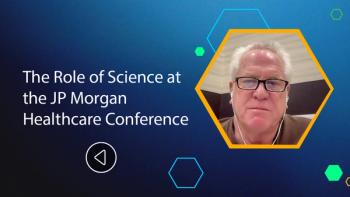
- Pharmaceutical Executive-06-01-2010
- Volume 0
- Issue 0
Managing Business Synergies
Pharma companies can maximize partnership benefits with social media.
While FDA November 2009 hearings on social media regulatory concerns focused primarily on guidelines governing pharma's consumer communications, one issue was largely overlooked during the hearings and ignored in the media coverage: the use of highly targeted social media sites for healthcare companies to communicate with other businesses within the industry, as well as service providers across the industry. And though FDA's oversight might indicate otherwise, this brand of business-to-business communication via secure online marketplaces—used to accelerate deal-making, sales, and collaboration—is expanding.
Peter von Dyck
The industry understands and is beginning to embrace interactive DTC opportunities, with several companies successfully interacting with consumers online, and a significant number working to incorporate it in their marketing communications strategy. A smaller number of companies realize that social media is a great tool (especially for biotechs, pharmas, and medical device firms during the myriad stages of researching, developing, and commercializing products) for interacting in non-consumer settings. This number is growing as social media changes the landscape for product development by creating endless possibilities to pull together the strengths of all parties—both for and against.
So what are some companies in other industries doing with social media in the B2B space, and what lessons can the pharmaceutical industry learn? The short answers: Some are using social media primarily to market themselves, and many have been or are well on their way to being successful. This networking can be done in a way that provides protection for each party's patents and intellectual property. Companies like Oracle, SAP, and
Leveraging Peer-to-Peer Connections
While most existing social media forums are too broad and shallow for the very specialized life sciences industry, they can serve as a means for DTC conversations and for creating basic B2B or peer-to-peer connections. Evidence shows that companies in the healthcare industry are increasingly using social media in business-to-business settings. LinkedIn, a leading business-oriented social networking site, has illustrated the viability of online marketplaces for networking among businesses and professionals. LinkedIn's growth has enabled the creation of specific industry groups—including dedicated pharma and medical device groups—within the larger site.
One function to look for in B2B sites is whether the site builds upon similar Web-based business sites that suggest links and products and possible connections to relevant members and technologies—a strategy similar to
John Miner, a senior licensing associate with the University of Central Florida's Technology Transfer office, coordinates the transfer activities for hundreds of technologies and is always seeking new opportunities to license, collaborate, or secure funding to develop new medical technologies. "Being able to easily and cost-effectively expand our contact list is one of the key benefits to being members of a B2B site dedicated to medical devices," says Miner. "In just a few short weeks, one site with which we have a membership linked us quickly and efficiently to new connections, which is saving our department time and revenue, and creating real partnering opportunities." Miner adds that the 2009 economy has forced the industry to be more cautious in developing and commercializing new products, but these types of online tools offer a powerful way to connect and collaborate versus the manual and traditional means.
The lesson for pharma is that while the Internet is the ultimate tool for mass communication (read: consumers), what makes it so useful is its ability to help create communities for specialized and geographically diverse audiences. While, ultimately, pharma's primary customers are healthcare professionals, the industry has many micro-audiences it must contact and partner with well before a product reaches either a prescriber or consumer. Dedicated groups have the ability to create relationships and dialogues, and this innate ability to connect people with similar goals offers the perfect tool for product development. What's more, the growing number of companies and individuals using the Internet's social media groups to find partners to help bring a product to market may also provide protection for patents and intellectual property.
Lessons from the Medical Device Industry
The challenges that healthcare companies face when bringing products from design to market can be overwhelming. These may include detailed road-mapping and planning around the development burdens of the product, as well as understanding early challenges so clinical plans can be designed properly to satisfy safety and efficacy standards and deal with regulatory approvals, competitive analysis, and reimbursement, eliminating the need to suspend development to secure additional capital.
The medical device industry provides a great example for pharma. In the B2B space, the medical device industry is extremely specialized with a relatively small universe of participants. It uses social media in a number of ways, including marketing products and building loyalty among customers like doctors, nurses, and patients. These sites can also create a feedback mechanism, and can be used as a customer relationship tool, as well as a useful tool for finding partners and creating collaborations across all segments of the product life cycle.
Social media's ability to create a collaborative environment also comes with a potential challenge: In this competitive environment, researchers, innovators, financiers, and manufacturers—and just about all participants across the industry—need to walk the fine line of accessing the community's collective knowledge and specialized skills while protecting valuable intellectual property, patent rights, and trade secrets that are the economic backbone of the sector.
In general, social media sites are not in tune with the needs of the healthcare or other industries that are both highly regulated and trade-secret sensitive. A great deal of the risk in using existing sites involves the potential for over-disclosure when communicating product development processes. Whether intentional or inadvertent, the discussion of critical patentable data could be catastrophic. Those few sites tailored to the confidential exchange of ideas are facilitating the Internet's role as the dominant means of collaboration and communication.
Beyond the multinational firms in pharma, there are many smaller companies and independent research institutions that find it impossible to bring a product from original idea to commercialization without an increasing number of service providers and strategic partnerships. Success for these smaller players requires continual research, a focus on promotion, internal knowledge-sharing, speed, and collaborative partnerships. For all of these reasons, pharmaceutical companies can greatly benefit from customized social media platforms with B2B groups dedicated to specific industries or product categories.
Pharmaceutical, biotech, and medical device firms—as well as university research departments, technology transfer agents, and independent researchers—should not be asking whether to engage in business to business social media, but how to leverage the new technologies and communications platforms to create a competitive advantage.
At the very least, each should begin to use these tools so they don't suffer business disadvantages as competitors take advantage of increased global efficiency. Companies should be using social media and specialized social/business networking sites to help them connect rapidly to other companies with which they share important synergies.
Used to its fullest potential, social media can change the way companies market to prospects, communicate with customers, and find and interact with the most appropriate potential business partners—all without incurring significant time and expense. While these initial efforts can feel foreign at first, the capital costs are typically low, which is good news for the budget-conscious as the economy continues a slow recovery.
Peter von Dyck is founder, CEO, and chairman of
Articles in this issue
over 15 years ago
Emerging Pharma Leaders 2010over 15 years ago
Pharmaceutical Executive Digital Edition - June 2010over 15 years ago
Pew's Rising Profile in Public Healthover 15 years ago
Moving Beyond Claims-Based Messagingover 15 years ago
Post-Approval Regulation: Progress or Pileup?Newsletter
Lead with insight with the Pharmaceutical Executive newsletter, featuring strategic analysis, leadership trends, and market intelligence for biopharma decision-makers.




